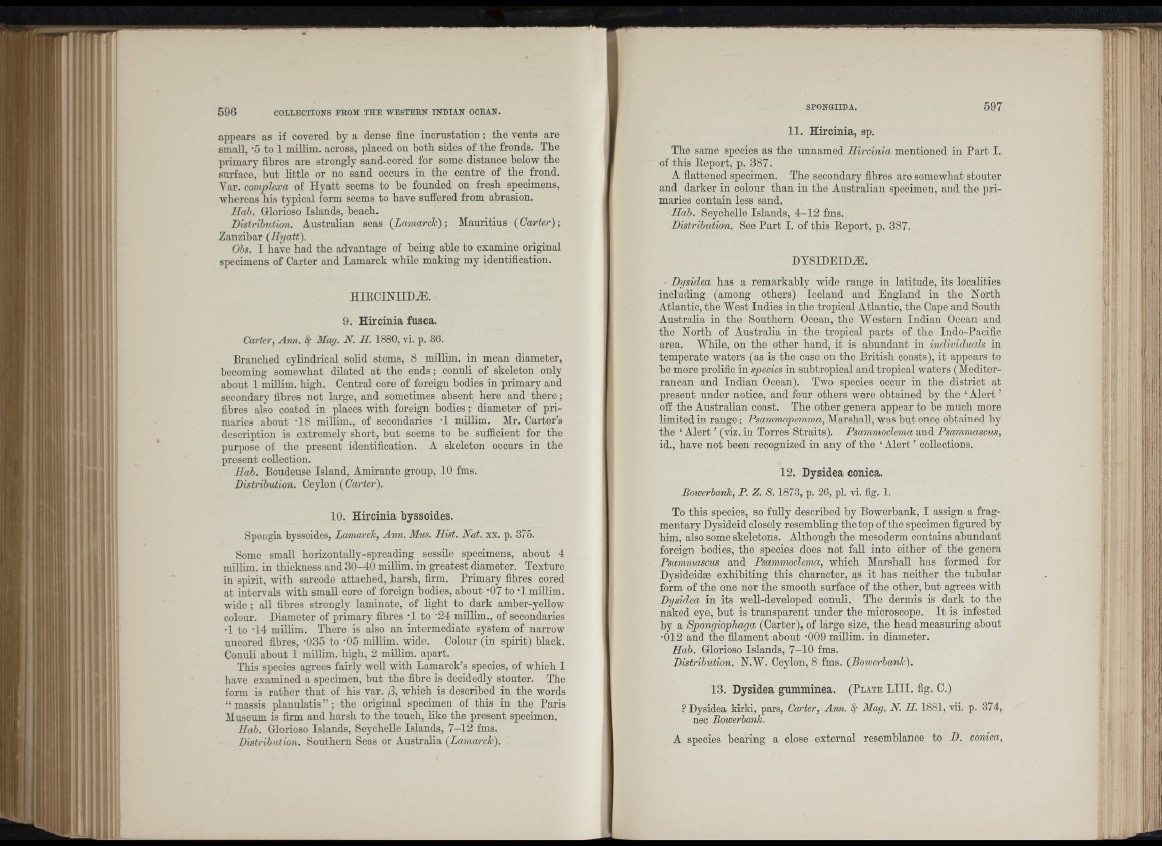
H
596 C O L L E C T I O N S E E O M T H E W E S T E K N I N D I A N O C E A N .
I ; .i
i'ii
appears as if covered by a dense fine incrustation ; tbe vents are
small, -5 to 1 millim. across, placed on botb sides of tbe fronds. Tbe
primary fibres are strongly sand-cored for some distance below tbe
surface, but little or no sand occurs in tbe centre of tbe frond.
Var. complexa of H y att seems to be founded on fresb specimens,
wbereas bis typical form seems to bave suffered from abrasion.
Hah. Glorioso Islands, beacb.
Distrihution. Australian seas (Lamarck); Mauritius (Carter);
Zanzibar (Hyatt).
Ohs. I bave bad tbe advantage of being able to examine original
specimens of Carter and Lamarck wbile making my identification.
HIllCINIIDriE.
9. Hircinia fusca.
Carter, Ann. 4" Mag. N. H. 1880, vi. p. 36.
Branched cylindrical solid stems, 8 miUim. in mean diameter,
becoming somewhat dilated a t the ends; conuli of skeleton only
about 1 millim. high. Central core of foreign bodies in primary and
secondary fibres not large, and sometimes absent here and th e re ;
fibres also coated in places with foreign bodies; diameter of primaries
about -18 millim., of secondaries -1 millim. Mr. Carter’s
description is extremely short, but seems to be sufficient for tbe
purpose of the present identification. A skeleton occurs in the
present coUection.
Hah. Boiideuse Island, Amirante group, 10 fms.
Distrihution. Ceylon (Carter).
10. Hircinia byssoides.
Spongia byssoides, Lamarck, Ann. Mus. Hist. Nat. xx. p. 375.
Some small horizontally-spreading sessile specimens, about 4
millim. in thickness and 30-40 miUim. in greatest diameter. Texture
in spirit, with sarcode attached, harsh, firm. Primary fibres cored
at intervals witb smaU core of foreign bodies, about -07 to -1 millim.
w id e ; aU fibres strongly laminate, of light to dark amber-yellow
colour. Diameter of primary fibres •! to ‘24 millim., of secondaries
•1 to -14 millim . There is also an intermediate system of narrow
uncored fibres, -035 to -05 millim. wide. Colour (in spirit) black.
Conuli about 1 millim. high, 2 millim. apart.
Tbis species agrees fairly weU with Lamarck’s species, of which I
have examined a specimen, but the fibre is decidedly stouter. Tbe
form is ratber that of his var. /3, which is described in the words
“ massis planulatis” ; tbe original specimen of tbis in tbe Paris
Museum is firm and harsh to tbe touch, like tbe present specimen.
Hab. Glorioso Islands, SeycbeUe Islands, 7-12 fms.
Distrihution. Southern Seas or Australia (Lamardc).
11. Hircinia, sp.
The same species as tbe unnamed Hircinia mentioned in P a rt I.
of tbis Peport, p. 387.
A flattened specimen. The secondary fibres are somewhat stouter
and darker in colour than in tbe Australian specimen, and the primaries
contain less sand.
Hah. Seychelle Islands, 4 -1 2 fms.
Distrihution. See P a rt I. of tbis Eeport, p. 387.
DYSIDEIDÆ.
Dysidea bas a remarkably wide range in latitude, its localities
incloding (among others) Iceland and England in tbe North
Atlantic, tbe West Indies in the tropical Atlantic, the Cape and South
Australia in tbe Southern Ocean, the Western Indian Ocean and
the North of Australia in the tropical parts of the Indo-Pacific
area. AVbile, on the other hand, it is abundant in individuals in
temperate waters (as is tbe case on the British coasts), it appears to
be more prolific in species in subtropical and tropical waters (Mediterranean
and Indian Ocean). Two species occur in tbe district at
present under notice, and four others were obtained by the ‘ Alert ’
off tbe Australian coast. Tbe otber genera appear to be mucb more
limited in range: Psammopemma, MarsbaU, was but once obtained by
tbe ‘ Alert ’ (viz. in Torres Straits). Psammoclema and Psammascus,
id., have not been recognized in any of tbe ‘ Alert ’ collections.
12. Dysidea conica.
Bowerhank, P. Z. 8. 1873, p. 26, pi. vi. fig. 1.
To this species, so fuUy described by Bowerbank, I assign a fragmentary
Dysideid closely resembling tbe top of tbe specimen figured by
him, also some skeletons. Although tbe mesoderm contains abundant
foreign bodies, tbe species does not faU into either of tbe genera
Psammascus and Psammodema, wbicb Marshall has formed for
Dysideidæ exhibiting tbis character, as it bas neither tbe tubular
form of the one nor tbe smooth surface of the other, but agrees with
Dysidea in its well-developed conuli. Tbe dermis is dark to the
naked eye, but is transparent under tbe microscope. I t is infested
by a Spongiophaga (Carter), of large size, the head measuring about
•012 and tbe filament about -009 millim. in diameter.
Hah. Glorioso Islands, 7 -10 fms.
Distrihution. N.W. Ceylon, 8 fms. (Bowerhank).
13. Dysidea gumminea. ( P l a t e L III. fig. C.)
? Dysidea kirki, pars, Carter, Ann. 8r Mag. N. H. 1881, vii. p. 374,
nec Bowerhank.
A species bearing a close external resemblance to D. conica.
¡ft:]
!• =
-■G.'i À'f
l i !«
il(
i t : •' ■ 4= ri If
ll
'i; '
-
te :